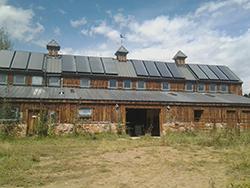Renewable Heating and Cooling
Agricultural production often involves industrial processes for handling or processing materials or products. Energy-intensive thermal processes include hot or chilled water, process heating, and/or space conditioning. These processes may be served by renewable heating and cooling technologies, including solar hot water or solar hot air systems, ground-source heat pumps (geothermal energy), or passive energy systems, such as ground-coupled, frost-free livestock watering tanks.
Examples of agricultural production and processing operations with high heating and cooling costs:
- Dairies
- Greenhouses
- Poultry houses
- Feed mills
- Breweries
- Cold storage
The Colorado Department of Agriculture has partnered with the Colorado Energy Office, the USDA Natural Resources Conservation Service-Colorado, and Rural Development-Colorado to promote renewable heating and cooling systems as part of an Agricultural Energy Management Plan (AgEMP). Even if you are not eligible for NRCS assistance through the EQIP program, Colorado agricultural producers and processors may be eligible for project assistance through the ACRE3program.
You can learn more about how to use renewable heating and cooling in your agricultural operation through the Colorado Agricultural Renewable Heating & Cooling Roadmap
Ready to get started? Learn how to participate in the Acre3 Program.
- Self-assessment Tools
- Publications
Colorado Agricultural Renewable Heating & Cooling Roadmap
UMN Extension: Cold-Climate Greenhouse Resource: A guidebook for designing and building a cold-climate greenhouse
NRCAN: Solar Water Heating Systems: A Buyer’s Guide
NRCAN: Heating Your Building with Solar Energy
Wisconsin Focus On Energy – Ten Easy Ways to Cut Energy Costs in Existing Greenhouse Spaces
